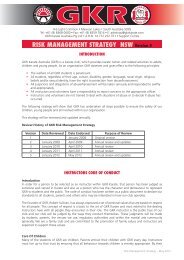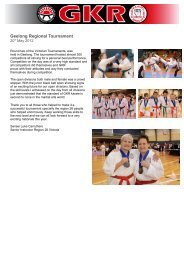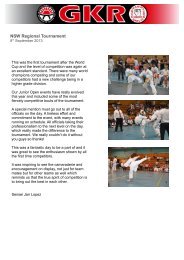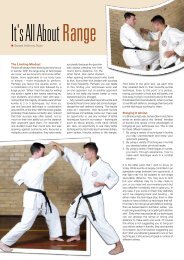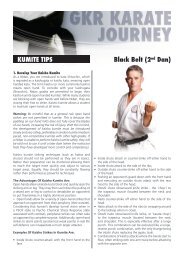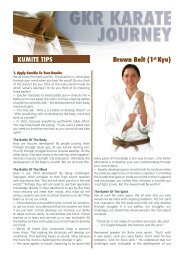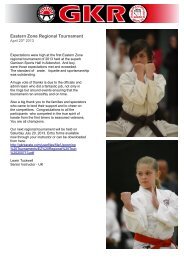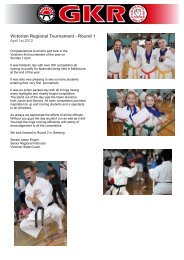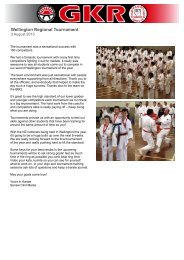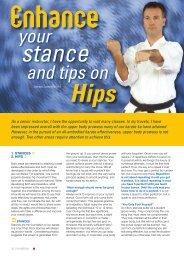Red Belt (4th Kyu) KumiTe TipS - GKR Karate
Red Belt (4th Kyu) KumiTe TipS - GKR Karate
Red Belt (4th Kyu) KumiTe TipS - GKR Karate
Create successful ePaper yourself
Turn your PDF publications into a flip-book with our unique Google optimized e-Paper software.
is not careful they might be attacked and scored upon<br />
during the process. Having achieved your <strong>Red</strong> belt, your<br />
fighting stance and footwork should be adequate enough<br />
to allow you to tap into your opponent’s guard without<br />
endangering yourself.<br />
The three keys to making this technique a success is as<br />
follows:<br />
i) Be quick with your front foot step and reach out. If<br />
you are slow you will find yourself in hot water.<br />
ii) Zanshin. Be aware your opponent may strike and be<br />
quick to get back to your guard.<br />
iii) Be prepared. Being aware is not enough, you must<br />
be prepared to counter strike or retreat should your<br />
opponent attack.<br />
It does not require any power, merely touching your<br />
opponent’s forearm or hand.<br />
» Be sure to touch from top position (rather than touching<br />
the bottom of their hand or forearm). Having your hand<br />
on top allows you to more effectively block should they<br />
attack, plus it allows you to lever their hand downwards<br />
and strike should you wish to.<br />
» So if this senjutsu (combat strategy) is more difficult<br />
than the feint, why should we use it?<br />
a) It disturbs their thinking. This prevents them from<br />
establishing attacking strategies as they are concerned<br />
about your potential attack.<br />
b) Advanced opponents are very good at distinguishing<br />
the difference between real attacks and feints.<br />
c) Advanced opponents rarely react until a technique is<br />
inside their reach.<br />
d) It encourages your opponent to attack. If you want your<br />
opponent to attack (allowing you to counter strike), this<br />
technique will often draw out their attack.<br />
e) It sets precedence. If you get inside your opponent’s<br />
range often (just to touch and retreat) they lose their<br />
sense of urgency each time you move forward. This<br />
happens subconsciously in kumite, where we start to<br />
feel we can predict our opponent’s movements. When<br />
you sense they have lost their sense of urgency to react,<br />
use your disturb tactic to get in close and lever their<br />
hand down - continuing on with a strike.<br />
8. Be A Moving Weapon, Not A Moving Target<br />
Some people hesitate to attack in kumite because they<br />
fear being picked off. Of course one trick is to get faster,<br />
but a more simple method is to put your opponent on the<br />
defensive before you start.<br />
» Think about the psychology for a moment. If you<br />
charge in with your body, waiting to get into range before<br />
throwing your first attack, what does your opponent see?<br />
A moving target! Hardly something intimidating to put you<br />
on the back foot.<br />
» It can pay dividends to launch your first attack while<br />
still short of your opponent. Sure it will be short but what<br />
do they see? A weapon moving towards them! Therefore<br />
their most likely reaction is to go into a defensive mindset<br />
(hence try to block). Now considering your first attack will<br />
land short, don’t forget to throw a second attack, because<br />
this now becomes your true intended attack.<br />
9. Empty Hand Doesn’t Imply No Weapons<br />
It is commonly known that the ‘te’ in ‘Kara-te’ means<br />
hand. The ‘Kara’ part originally meant China. So kara-te<br />
translated as ‘China-hand’. In 1936, the Okinawa masters<br />
decided that the term China was no longer appropriate as<br />
karate no longer resembled Chinese arts. It has evolved to<br />
become its own original art.<br />
» So the kanji that symbolised the ‘Kara’ component was<br />
changed to one that translated as ‘Empty’. So kara-te now<br />
translated as ‘empty-hand’.<br />
» Because of this translation however, people often<br />
presume that ‘empty-hand’ means ‘no weapons’.<br />
Therefore, when confronted with a real life situation, most<br />
karate-ka will naturally resort to focusing on using their<br />
body as a weapon in self-defence.<br />
» While it is true that, by-and-large, karate is an unarmed<br />
form of self-defence, it does not mean that a karate-ka<br />
should neglect weapons. To begin with, a number of<br />
the old Okinawa masters (who formed the name ‘empty<br />
hand’) actually trained with weapons. And the majority<br />
of the weapons practised were regular household items<br />
or farming tools. Even a number of kata practised today<br />
were also practised with weapons. For example, Kururunfa<br />
is often practised as a Sai kata (Sai was a weapon taken<br />
from farming tools) and Sepai is often practised as a sword<br />
kata.<br />
» Secondly, one must remember that karate does not<br />
teach a set of appropriate responses to a limited number<br />
of self-defence scenarios. Rather, it teaches self-defence<br />
principles that could work in any situation. Therefore,<br />
whether you are unarmed, or have something in your hand,<br />
the principles found in karate can be used identically.<br />
» In other words, if you are ever confronted, if anything<br />
is in your vicinity that could be used as a weapon (eg a<br />
chair, a bin lid, your belt or high heel shoe, a handbag, a<br />
book, car keys etc) then be sure to grab it. The principles<br />
of karate can still come out because a weapon is no more<br />
than an extension of the body.<br />
» Don’t change the principles to your kumite. Keep your<br />
stance, use your body in your techniques, maintain zanshin<br />
etc. What you are doing is practising these principles with<br />
something in your hand. This will not only train you but<br />
help to remind you to look for weapons (big or small, sharp<br />
or blunt etc) should you ever get attacked.<br />
10. Never Forget: <strong>Karate</strong> Begins With Rei And<br />
Ends With Rei<br />
Having reached <strong>Red</strong> belt, it’s likely that your kumite will<br />
start to become a little more competitive. When this<br />
occurs we may find ourselves getting the occasional knock.<br />
Furthermore as both we and our fellow students will be<br />
experimenting with new techniques and principles, bouts<br />
may get a little scrappy. It’s important during these times



